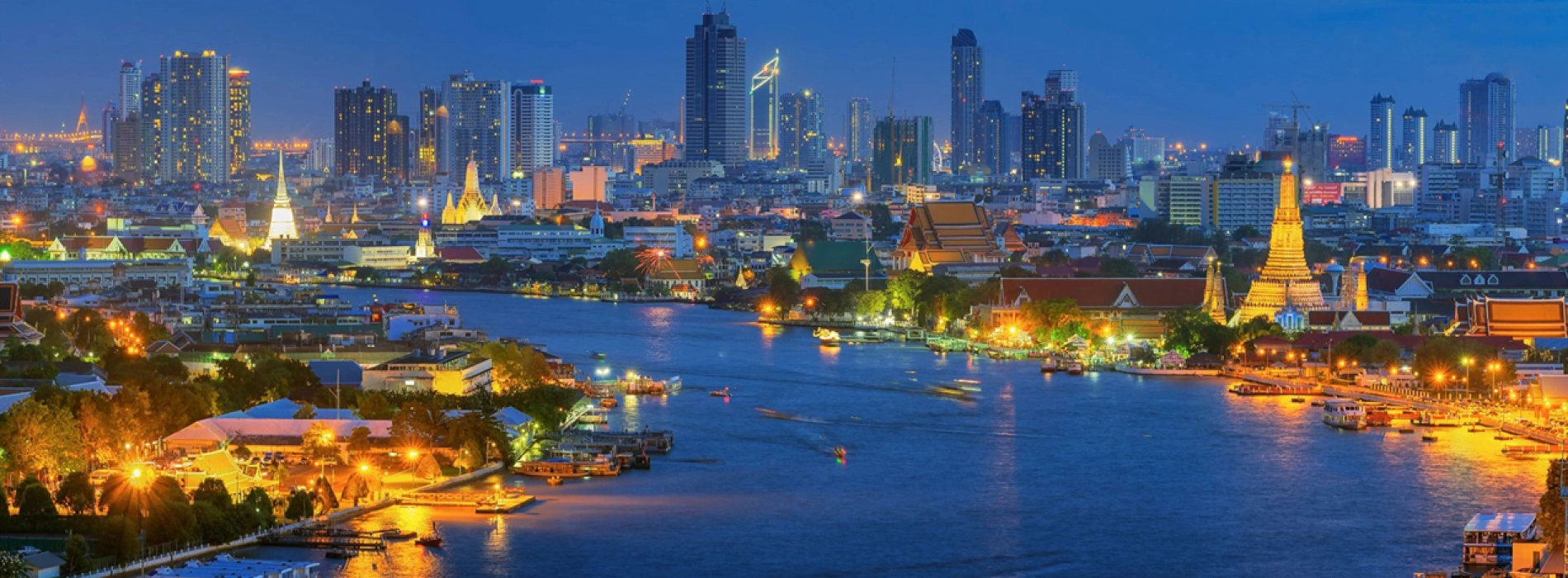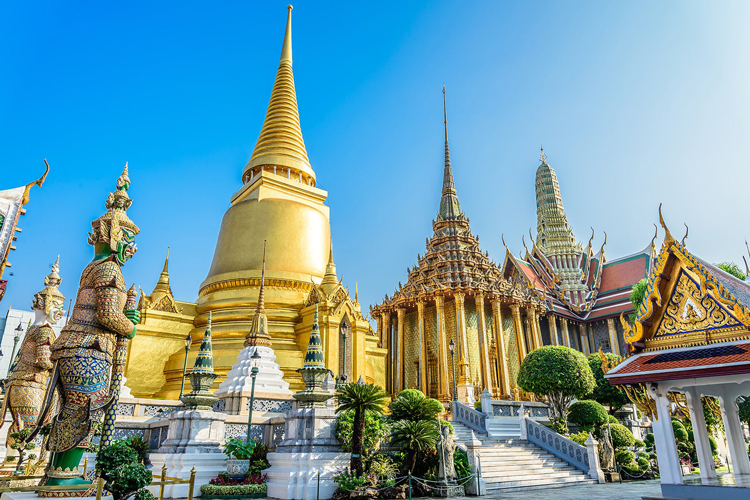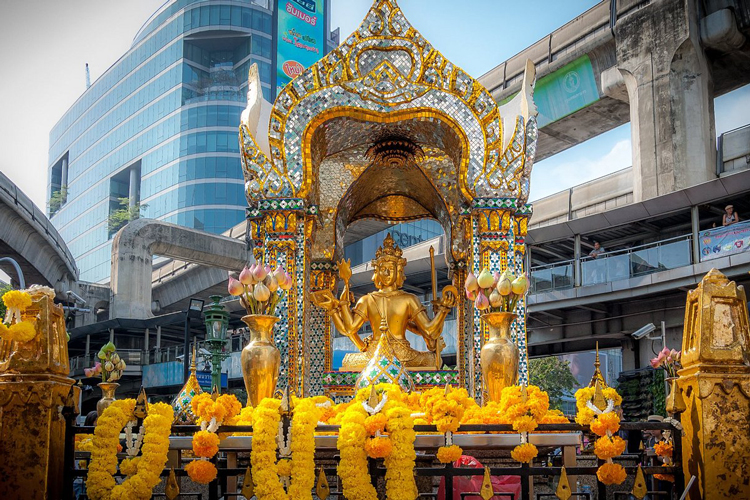Bangkok

Bangkok, the capital of Thailand, spans an area of 1568.7 km2 and boasts a population of approximately 8 million people. As the most populous city in the "Land of the Golden Temple," it constitutes one-fifth of the country's total population. Originating as a small town within the Ayutthaya kingdom, Bangkok underwent rapid development, particularly thriving due to advancements in trade. Its significant growth occurred between 1960 and 1980, propelling it to become Thailand's primary economic, cultural, and educational hub. Functioning as a crucial gateway, Bangkok serves as a vital link connecting renowned tourist destinations in Thailand. Whether embarking on an independent journey or joining a guided tour of Thailand, Bangkok is an indispensable destination in the Land of Golden Temples. Visitors are treated to a skyline adorned with skyscrapers, iconic landmarks, modern shopping centers, and a rich array of diverse and unique cuisine.

Grand Palace and Wat Phra Kaew, Bangkok
Bangkok's history is intricate, spanning centuries of evolution. Originating as a modest trading post during the Ayutthaya Kingdom, the city's narrative unfolds through various periods.
In the aftermath of Ayutthaya's fall in 1767, King Taksin founded the Thonburi Kingdom. In 1782, King Rama I relocated the capital across the Chao Phraya River, naming it Krung Thep or the "City of Angels."
Rattanakosin Period (1782–Present): Under the Chakri Dynasty, Bangkok blossomed as the capital of Siam, witnessing the construction of the Grand Palace and substantial urban growth. The 19th century marked modernization efforts during the reigns of King Mongkut and King Chulalongkorn, including the Bowring Treaty and extensive infrastructure projects. Bangkok navigated through World War II as an officially neutral but Japanese-occupied territory. Post-war, the city underwent rapid urbanization, emerging as a key economic and cultural hub in Southeast Asia.
Contemporary Era: In the late 20th century, Bangkok grappled with challenges such as population growth, traffic congestion, and pollution. The city's trajectory continued in the 21st century, witnessing global city status with a diverse economy, modern infrastructure, and a thriving cultural scene.
Key Events:
- The city served as a focal point for student protests against the military dictatorship in the 1970s.
- The 1997 Asian Financial Crisis posed economic challenges impacting Bangkok's development.
- Throughout the 21st century, Bangkok experienced periods of political protests and instability.
Bangkok, blending traditional Thai culture with modernity, has evolved from a humble trading post to a bustling metropolis. Its historical landmarks, vibrant street life, and cultural depth captivate visitors, making it a compelling destination.

The Erawan Shrine - A symbol of spiritual devotion and cultural richness of Bangkok
Similar to many regions in Thailand, Bangkok has a savanna climate, classified under the Köppen climate system, and is influenced by the Southeast Asian monsoon. The city encounters three distinct seasons: dry, rainy, and cool. Despite year-round high temperatures, ranging from an average low of 22 °C in December to an average high of 35.4 °C in April, these seasons bring variations in weather patterns.
The onset of the rainy season is marked by the arrival of the southwest monsoon around mid-May, with September being the wettest month, experiencing an average rainfall of 334.3mm. This rainy period extends until October. Following this, the dry season ensues, accompanied by cold winter winds that last until February. Although the dry season is generally hot with minimal rainfall, occasional summer storms may occur.
In essence, the optimal time to travel to Thailand is typically from December to March of the following year. However, it's worth noting a potential drawback of occasional heavy rainfall, even on the sunniest days. It's advisable to steer clear of visiting Thailand during the rainy season, spanning from May to October. For those seeking more open spaces with fewer crowds, the periods from April to June and from September to October are suitable. While some boat services to smaller islands may halt during the low season, hotel prices generally decrease. April tends to be particularly hot, while September and October are typically rainier.
The recommended duration for a visit to Bangkok varies depending on personal preferences and planned activities.
2-3 Days: Spending 2 to 3 days allows for a quick exploration of key attractions like the Grand Palace and vibrant markets.
4-5 Days: Extending the stay to 4 or 5 days provides more time to delve into cultural aspects, explore diverse neighborhoods, and enjoy the culinary scene.
7 Days or More: For a comprehensive exploration of Bangkok and its surroundings, including lesser-known areas, cultural events, and day trips to nearby attractions.

The impressive and artistry architecture of Wat Pho - the traditional Thai temple.
Skytrain BTS: BTS offers swift and convenient transportation with Silom and Sukhumvit lines. Individual ticket prices vary from 10 to 52 THB. A One Day Pass for 130 THB is available for multiple daily uses.
MRT: MRT operates on the Bang Sue - Sukhumvit - Silom - Hua Lamphong route. Ticket prices range from 16 to 40 THB, depending on stations passed.
Tuk - Tuks: Tuk Tuks offer a unique Bangkok experience but are suitable for short trips due to higher prices and lack of amenities. Agree on the fare in advance to avoid misunderstandings.
Taxi: Taxis are popular, especially in areas without BTS or MRT like Chinatown or Khaosan. Initial fare is 35 THB, remaining the same for the first 2km, then a 5 THB increase per kilometer.
Bus: Bangkok has many buses with diverse routes. Bus prices range from 7 to 22 THB, and air-conditioned EURO 2 buses have a higher comfort level.
River Bus: Ideal for exploring Chao Phraya River, the orange train visits famous attractions. The train price is 15 THB, and you can access it from Sathorn wharf.
Self-driving Car Rental: Numerous shops offer self-driving motorbike and car rentals. A valid driver's license and understanding of traffic laws are prerequisites for choosing this option.
Discovering the neighboring provinces from Bangkok offers a diverse range of transportation options:
Train: Bangkok's railway system establishes connections with nearby provinces like Ayutthaya, Lopburi, and Nakhon Pathom.
Minivans: Minivans, operating from multiple stations, are a favored choice for short trips to destinations like Pattaya, Hua Hin, and Ayutthaya.
Buses: Intercity buses present an economical travel option to neighboring provinces, offering various services from standard to VIP.
Taxi: Taxis are readily available for day trips, where you can negotiate a fare or choose a metered taxi for convenience.
Car Rental: Renting a car provides flexibility for independent exploration of neighboring provinces at your preferred pace, particularly useful for visiting multiple destinations in a day.
Boat Tours: Boat tours offer a unique perspective for exploring riverside provinces such as Nakhon Pathom or Samut Songkhram.
Motorbike Rental: For shorter distances and more adventurous journeys, consider renting a motorbike. Ensure you possess a valid license and adhere to safety guidelines.
Domestic Flights: Consider domestic flights from Don Mueang or Suvarnabhumi Airport for more distant destinations.
In our Bangkok Tour 3 days: Exploring Golden Temples, you will have chance to ad...
This Bangkok Tour 4 days: City Exploration offers you the highlights of Thailand...
Explore Bangkok with your family for 5 fun-filled days! This Bangkok Tour 5 days...
This Center Thailand Cycling Tour 3 days: Bangkok - Chanthaburi whisks you from...
Discover the vibrant heart of Thailand with our Thailand Tour 5 Days: Bangkok an...
Experience the Bangkok Pattaya Tour 5 Days for an ideal mix of fun, culture, and...